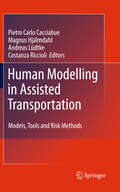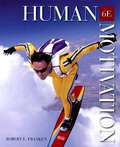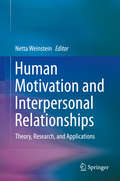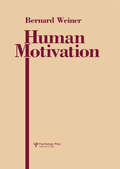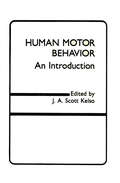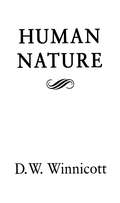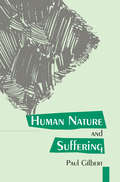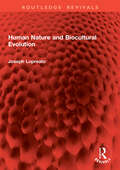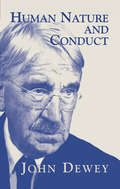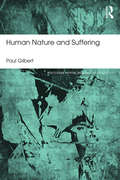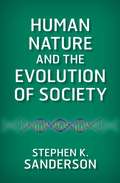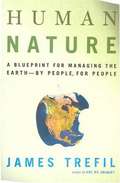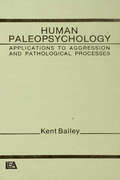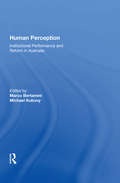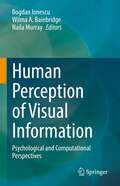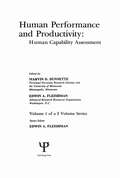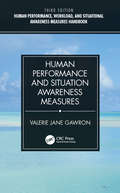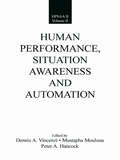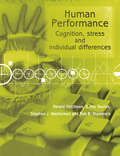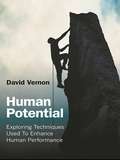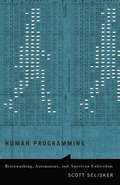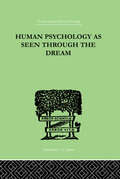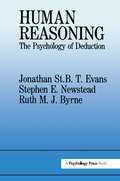- Table View
- List View
Human Microbiome in Health, Disease, and Therapy
by Pallaval Veera BramhachariThis book illustrates the role of the human microbiome in health and diseases. It discusses the association of an imbalanced human microbiome with different human diseases, including inflammatory, metabolic conditions, neurological, cardiovascular, and respiratory diseases. The book further reviews the association between intestinal microbiota and immune defense systems. The book provides evolving knowledge of the development, complexity, and functionality of the healthy gut microbiota and covers interventions that modulate and stabilize the gut microbiota. Further, it introduces the human microbiome as a reservoir of AMR genes, the current knowledge on the resistome, and the recent and upcoming advances in molecular diagnostic approaches to unravel this reservoir. Toward the end, the book reviews the advances in understanding the human urinary microbiome and its potential role in urinary tract infection. The chapter also presents the dynamics of the skin microbiome and the association of microbiota with skin disorders and therapeutic interventions. This book is an invaluable read for health professionals, medical students, microbiologists, and scientific research communities who are eager to update themselves with recent trends in microbiome research.
Human Modelling in Assisted Transportation
by Carlo Cacciabue Magnus Hjälmdahl Costanza Riccioli Andreas LuedtkeThe objective of this Workshop is to confront models, methods and tools developed within the projects with the ongoing research worldwide and to provide an environment for fruitful exchange of ideas. The main topics are: 1. Advanced human models in transportation. 2. Human Errors and Risk Assessment in design processes of assistance systems. 3. Methods and tools to prevent erroneous behaviour to mitigate its consequences. The Workshop will consist of 10 keynote lectures as well as approximately 28 peer reviewed papers.
Human Motivation (Sixth Edition)
by Robert E. FrankenThis Sixth Edition provides a thorough introduction to the basic facts and major theories of human motivation. Throughout the book, the author addresses the types of questions that often arise, such as "Why are some people more organized than others?" and "Why do people dream?" In his exploration of day-to-day human motivation, Franken provides a topical organization that shows students how biology, learning, and cognition interact with individual differences to produce human behavior.
Human Motivation and Interpersonal Relationships
by Netta WeinsteinThis volume summarizes and organizes a growing body of research supporting the role of motivation in adaptive and rewarding interpersonal interactions with others. The field of human motivation is rapidly growing but most studies have focused on the effects of motivation on individuals' personal happiness and task engagement. Only recently have theorists and empiricists begun to recognize that dispositional and state motivations impact the ways individuals approach interpersonal interactions. In addition, researchers are now recognizing that the quality of interpersonal interactions influences consequent happiness and task engagement, thus helping to explain previous findings to this end. Similarly social psychology and relationships researchers have focused on the impact of cognitions, emotions, and behaviors on people's relationships. In their work, relationships researchers demonstrate that both contextual characteristics and individual differences influence the quality of interactions. Many of these studies seek to understand which characteristics strengthen the bonds between people, encourage empathy and trust and create a sense of well-being after a close interaction. This work seeks to integrate the field of human motivation and interpersonal relationships. Both fields have seen extensive growth in the past decade and each can contribute to the other. However, no single compiled work is available that targets both fields. This is the case, in part because only now is there enough work to make a strong and compelling case for their integration. In the previous years, research has been conducted to show that motivation is relevant and important for interactions among strangers and in close relationships. In addition developmental mechanisms for these relations are identified and mechanisms by which motivation strengthens people's relationships. Finally recent work has demonstrated the many implications for interpersonal relationships, showing that motivation impacts a range of interpersonal processes from prejudice regulation and objectification of others to empathy and care. This book seeks to summarize and organize all these findings and present them in a way that is relevant to both motivation researchers and social and relationship researchers.
Human Motivation: Metaphors, Theories, And Research
by Bernard WeinerWeiner introduces -- and offers his own motivation for producing - - this most impressive work with the following: There are two distinct approaches to the study of motivation. One stratagem is a product of academic, experimental procedures, while the second is an outgrowth of clinical, non-experimental methods. Each of the approaches has unique advantages and disadvantages. But all investigators in this field are guided by a single basic question, namely, "Why do organisms think and behave as they do?" To help answer that basic question, Human Motivation presents an entire range of motivation studies -- from psychoanalytic, social learning and humanistic theory; to social facilitation, arousal, emotions, personal responsibility, and the irrationality of attributions; through chapterand verse of Hullian and Lewinian theory.
Human Motor Behavior: An Introduction
by J.A. Scott KelsoWhy should anyone be interested in studying motor skills? This book is based on the contrary belief that the determinants of motor skill and the conjoint problems of how movements are coordinated and controlled are fundamentally important to anyone concerned with understanding human behavior. This includes psychologists, but applies even more especially to other disciplines-such as physical education and kinesiology-for which the subject of movement is particularly germane. In fact, this book is written primarily for undergraduates in kinesiology and physical education as well as psychology, and it may also be of interest to students in areas such as physical therapy, engineering and computer science.
Human Nature
by D. W. WinnicottFirst published in 1990. Routledge is an imprint of Taylor & Francis, an informa company.
Human Nature And Conduct
by John Dewey John CappsIn Human Nature and Conduct, the philosopher John Dewey looks at the connection between human nature and morality. While some people believe that we are naturally good, others believe that we are naturally evil. Likewise, while some people believe that morality is all relative, others believe that moral laws are as universal as laws of nature. In these twenty-six succinct chapters Dewey argues that morality is not so simple. He claims that morality depends on both individual people and societies, on both nature and nurture, and on a complex interaction between biological impulses, social customs, and human intelligence. He argues against those who believe morality depends on the will of the majority, those who believe it depends on the will of God and, most of all, those who believe the purpose of morality is to protect us from our own instincts. In Human Nature and Conduct Dewey gives us a new perspective on morality.
Human Nature And Suffering (Routledge Mental Health Classic Editions Ser.)
by Paul GilbertThis volume explores the implications of humans as evolved social animals. Gilbert suggests that evolution has given rise to a varied set of social competencies which form the basis of our personal knowledge and understanding. These competencies are classified as: a) Care eliciting b) Care giving c) Co?operating and d) Competing. Each of these are seen as core schemata, or archetypal potentials around which knowledge is built, and from which, our propensity for suffering flow. For example our predisposition to think of ourselves as superior or inferior to others comes from innate competencies which evolve from dominance and social ranking. Gilbert shows how primitive competencies become modified by experience and what happens when this modification is unsatisfactory, for example leading to preoccupations with fantasy and behaviour which is dominance and power focused. Throughout the text Gilbert shows how two psychological systems (derived from ethological and experimental work), labelled the defense and safety system dominate the unfolding and integration of human mental life. In the last chapter these varied themes are brought together to indicate how the social construction of self arises from the organization of knowledge encoded within the four competencies. Gilbert highlights how cultural factors may modify and activate many of our more primitive competencies leading not only to pathology proneness but also to behaviours that are collectively survival threatening.
Human Nature and Biocultural Evolution (Routledge Revivals)
by Joseph LopreatoFirst published in 1984, Human Nature and Biocultural Evolution aims to delineate a theory of human nature, viewed as an interrelated set of genetically programmed behavioral predispositions, and a theory of biocultural evolution. The author’s approach is based on the hypothesis that innate predispositions and cultural-environmental factors cooperate to determine human behavior and socio-cultural forms.Professor Lopreato begins by tracing the development of evolutionary biology up to sociobiology. It is his argument that the social and biological disciplines have, for over a century, been moving towards a synthesis, and that Homo sapiens is neither just another animal, nor so unique a being that culture has become divorced from its genetic underpinnings. The argument is supported with evidence from evolutionary biology and social science, with a critical discussion of basic issues of behavioral science and with an analysis of certain famous theories in social science (e.g. theories of suicide, anomie, capitalism), which prove to be richer and more complete when viewed from a biocultural perspective.The theory of human nature is arrived at through a rich analysis of ethnographic, psychological, and sociological arguments and data, as well as facts and theories from comparative zoology. In the process, the author treats critically numerous theoretical problems associated with topics such as exploitation, class consciousness, structured inequality, reciprocal behavior, territorial aggression, religious ritual, socialization, ethnicity, and prejudice. The author concludes with an examination of behavioral predispositions that are hypothesized to be at the base of cultural variation.
Human Nature and Conduct
by John DeweyA morality "based on the study of human nature instead of upon disregard for it" is the focus of this influential work by one of America's greatest educators and philosophers. John Dewey maintains that the key to social psychology lies in an understanding of the many varieties of habit; individual mental activity, on the other hand, is guided by the subordinate factors of impulse and intelligence."The mind," Dewey asserts, "can be understood in the concrete only as a system of beliefs, desires, and purposes which are formed in the interaction of biological aptitudes with a social environment." His investigation focuses on three main areas: the place of habit in conduct; the place of impulse in conduct; and the place of intelligence in conduct. Each factor receives an incisive treatment, brimming with ideas, insights, and considered reflections.This classic of its genre presents a rich banquet of food for thought, certain to be appreciated by educators, psychologists, philosophers, and anyone interested in the role of the individual in society.
Human Nature and Suffering (Routledge Mental Health Classic Editions)
by Paul GilbertHuman Nature and Suffering is a profound comment on the human condition, from the perspective of evolutionary psychology. Paul Gilbert explores the implications of humans as evolved social animals, suggesting that evolution has given rise to a varied set of social competencies, which form the basis of our personal knowledge and understanding. Gilbert shows how our primitive competencies become modified by experience - both satisfactorily and unsatisfactorily. He highlights how cultural factors may modify and activate many of these primitive competencies, leading to pathology proneness and behaviours that are collectively survival threatening. These varied themes are brought together to indicate how the social construction of self arises from the organization of knowledge encoded within the competencies. This Classic Edition features a new introduction from the author, bringing Gilbert's early work to a new audience. The book will be of interest to clinicians, researchers and historians in the field of psychology.
Human Nature and the Evolution of Society
by Stephen K. SandersonIf evolution has changed humans physically, has it also affected human behavior? Drawing on evolutionary psychology, sociobiology, and human behavioral ecology, Human Nature and the Evolution of Society explores the evolutionary dynamics underlying social life. In this introduction to human behavior and the organization of social life, Stephen K. Sanderson discusses traditional subjects like mating behavior, kinship, parenthood, status-seeking, and violence, as well as important topics seldom included in books of this type, especially gender, economies, politics, foodways, race and ethnicity, and the arts. Examples and research on a wide range of human societies, both industrial and nonindustrial, are integrated throughout. With chapter summaries of key points, thoughtful discussion questions, and important terms defined within the text, the result is a broad-ranging and comprehensive consideration of human society, thoroughly grounded in an evolutionary perspective.
Human Nature: A Blueprint for Managing the Earth-By People, for People
by James S. TrefilTrefil, a leading scientist, is certainly qualified to tackle the controversial, timely topic of how humans ought to affect the planet they live on. He argues that from the dawn of an agricultural society, man has always engineered nature to suit his needs. And because we're the only form of life with the ability to move mountains (as much literally as metaphorically), there's no rational reason not to manage the environment
Human Paleopsychology: Applications To Aggression and Patholoqical Processes
by K. BaileyFirst Published in 1986. In this book the author seeks to demonstrate his believe that any credible view must grapple not only with human distinctiveness (e.g., learning capacity, language, rationality, and culture), but the dark sides of senseless violence and social disorder as well. Any such grappling with the dark side must necessarily confront our animal natures as well as our distinctly human natures.
Human Perception
by Marco Bertamini Michael KubovyIt takes little or no effort for us to gather information by means of our senses but it would be a mistake to take this as a sign that perception is simple. It was in the 20th century and after the establishment of psychology as a scientific discipline that the study of perception flourished. This important volume gathers together a selection of articles and essays which represent some of the most interesting discoveries and theories. It gives a flavour of the many different approaches and ideas taken by cognitive psychologists in this fascinating area. Topics covered include: attention, brain systems, object interpolation and completion, object recognition and classification, different types of objects, and information processing and models.
Human Perception of Visual Information: Psychological and Computational Perspectives
by Bogdan Ionescu Wilma A. Bainbridge Naila MurrayRecent years have witnessed important advancements in our understanding of the psychological underpinnings of subjective properties of visual information, such as aesthetics, memorability, or induced emotions. Concurrently, computational models of objective visual properties such as semantic labelling and geometric relationships have made significant breakthroughs using the latest achievements in machine learning and large-scale data collection. There has also been limited but important work exploiting these breakthroughs to improve computational modelling of subjective visual properties. The time is ripe to explore how advances in both of these fields of study can be mutually enriching and lead to further progress.This book combines perspectives from psychology and machine learning to showcase a new, unified understanding of how images and videos influence high-level visual perception - particularly interestingness, affective values and emotions, aesthetic values, memorability, novelty, complexity, visual composition and stylistic attributes, and creativity. These human-based metrics are interesting for a very broad range of current applications, ranging from content retrieval and search, storytelling, to targeted advertising, education and learning, and content filtering.Work already exists in the literature that studies the psychological aspects of these notions or investigates potential correlations between two or more of these human concepts. Attempts at building computational models capable of predicting such notions can also be found, using state-of-the-art machine learning techniques. Nevertheless their performance proves that there is still room for improvement, as the tasks are by nature highly challenging and multifaceted, requiring thought on both the psychological implications of the human concepts, as well as their translation to machines.
Human Performance and Productivity: Volumes 1, 2, and 3
by Marvin D. Dunnette Edwin A. FleishmanThese volumes represent a concerted attempt to link what is known from human performance research to recognized national needs for improving productivity. The product of a National Science Foundation project directed by the series editor, the set features authoritative reviews by leading psychologists in the field. The volumes cover many areas of human performance not included in other books.
Human Performance and Situation Awareness Measures
by Valerie GawronThis book was developed to help researchers and practitioners select measures to be used in the evaluation of human/machine systems. The book begins with an overview of the steps involved in developing a test to measure human performance. This is followed by a definition of human performance and a review of human performance measures. Another section defines situational awareness with reviews of situational awareness measures. For both the performance and situational awareness sections, each measure is described, along with its strengths and limitations, data requirements, threshold values, and sources of further information. To make this reference easier to use, extensive author and subject indices are provided. <P><P>Features <li>Provides a short engineering tutorial on experimental design <li>Offers readily accessible information on human performance and situational awareness (SA) measures <li>Presents general description of the measure <li>Covers data collection, reduction, and analysis requirements <li>Details the strengths and limitations or restrictions of each measure, including proprietary rights or restrictions
Human Performance, Situation Awareness, and Automation: Current Research and Trends HPSAA II, Volumes I and II
by Peter A. Hancock Mustapha Mouloua Dennis A. VincenziIn 2000, the Conference on Automation joined forces with a partner group on situation awareness (SA). The rising complexity of systems demands that one can be aware of a large range of environmental and task-based stimulation in order to match what is done with what has to be done. Thus, SA and automation-based interaction fall naturally together and this conference is the second embodiment of this union. Moving into the 21st century, further diversification of the applications of automation will continue--for example, the revolution in genetic technology. Given the broad nature of this form of human-machine interaction, it is vital to apply past lessons to map a future for the symbiotic relationship between humans and the artifacts they create. It is as part of this ongoing endeavor that the present volume is offered.
Human Performance: Cognition, Stress and Individual Differences
by Gerald Matthews D. Roy Davies Rob B. Stammers Steve J. WestermanHuman Performance provides the student and researcher with a comprehensive and accessible review of performance, in the real world and essential cognitive science theory.Four main sections cover both theoretical and practical issues: Section One outlines the perspectives on performance offered by contemporary cognitive science, including information processing and neuroscience perspectives.Section Two presents a multi-level view of the performer as biological organism, information-processor and intentional agent. It reviews the development of the cognitive theory of performance through experimental studies and also looks at practical issues such as human error.Section Three reviews the impact of stress factors such as noise, fatigue and illness on performance. Section Four assesses individual and group differences in performance with accounts of ability, personality and aging.
Human Potential: Exploring Techniques Used to Enhance Human Performance
by David VernonThroughout time, people have explored the ways in which they can improve some aspect of their performance. Such attempts are more visible today, with many working to gain an ‘edge’ on their performance, whether it is to learn a new language, improve memory or increase golf handicaps. This book examines a range of techniques that are intended to help improve some aspect of performance, and examines how well they are able to achieve this. The various performance enhancing techniques available can be divided into those where the individual remains passive (receiving a message, suggestion or stimulus) and those where the individual needs to take a more active approach. Human Potential looks at a range of techniques within each of these categories to provide the reader with a sense of the traditional as well as the more contemporary approaches used to enhance human performance. The techniques covered include hypnosis, sleep learning, subliminal training and audio and visual cortical entrainment as well as mnemonics, meditation, speed-reading, biofeedback, neurofeedback and mental imagery practice. This is the first time such a broad range of techniques has been brought together to be assessed in terms of effectiveness. It will be useful to all psychology and sports science students, practicing psychologists, life coaches and anyone else interested in finding out about the effectiveness of performance enhancement techniques.
Human Programming: Brainwashing, Automatons, and American Unfreedom
by Scott SeliskerDo our ways of talking about contemporary terrorism have a history in the science, technology, and culture of the Cold War? Human Programming explores this history in a groundbreaking work that draws connections across decades and throughout American culture, high and low. Scott Selisker argues that literary, cinematic, and scientific representations of the programmed mind have long shaped conversations in U.S. political culture about freedom and unfreedom, and about democracy and its enemies. Selisker demonstrates how American conceptions of freedom and of humanity have changed in tandem with developments in science and technology, including media technology, cybernetics, behaviorist psychology, and sociology. Since World War II, propagandists, scientists, and creative artists have adapted visions of human programmability as they sought to imagine the psychological manipulation and institutional controls that could produce the inscrutable subjects of totalitarian states, cults, and terrorist cells. At the same time, writers across the political spectrum reimagined ideals of American freedom, democracy, and diversity by way of contrast with these posthuman specters of mental unfreedom. Images of such &“human automatons&” circulated in popular films, trials, travelogues, and the news media, giving form to the nebulous enemies of the postwar and contemporary United States: totalitarianism, communism, total institutions, cult extremism, and fundamentalist terrorism. Ranging from discussions of The Manchurian Candidate and cyberpunk science fiction to the cases of Patty Hearst and the &“American Taliban&” John Walker Lindh, Human Programming opens new ways of understanding the intertwined roles of literature, film, science, and technology in American culture.
Human Psychology As Seen Through The Dream (International Library Of Psychology Ser.)
by Turner, JuliaFirst published in 1999. Routledge is an imprint of Taylor & Francis, an informa company.
Human Reasoning: The Psychology Of Deduction
by Ruth M.J. Byrne Stephen E. Newstead Jonathan St.B.T. EvansDeductive reasoning is widely regarded as an activity central to human intelligence, and as such has attracted an increasing amount of psychological study in recent years. In this first major survey of the field for over a decade, the authors provide a detailed and balanced review of all the main kinds of deductive reasoning task studied by psychologists. Topics covered include conditional and disjunctive reasoning, the Wason selection task, relational inference and reasoning with syllogisms and quantifiers. Throughout the review, a careful distinction is drawn between the main empirical findings in the field and the major theoretical approaches proposed to account for these findings. Discussion of experimental findings is organized around three central questions: What is the extent and limitation of human competence in deductive reasoning? What factors are responsible for systematic errors and biases on reasoning tasks? How is human reasoning influenced by the content in which logical problems are presented? Four major classes of theory are discussed throughout the book. The long established theory that people have a mental logic comprised of formal rules of inference is contrasted particularly with the recently developed mental model theory of deductive reasoning. Explanations of many phenomena, especially biases, are also considered in terms of heuristic processes. Finally, consideration is given to accounts of content and context effects based upon the use of domain sensitive rules or schemas. The book ends with a discussion of research on deductive reasoning in the context of the current debate about human rationality.

